Evidence-Based Nursing Report: Medication Errors and Interventions
VerifiedAdded on 2022/11/12
|25
|4697
|369
Report
AI Summary
This nursing report addresses the critical issue of medication errors within the Australian healthcare system. The report begins by identifying medication errors as a significant clinical problem, highlighting their impact on patient safety and healthcare expenditure. It provides a literature review, including a systematic search strategy using databases like Google Scholar and Medline, and presents a hierarchy of evidence from various research studies. The report synthesizes findings from multiple studies, focusing on interventions to reduce medication errors. It identifies the highest level of evidence using the JBI checklist for critical appraisal of systematic reviews. The report discusses the causes of medication errors, such as workload, interruptions, and lack of training, and explores effective interventions like training programs, automated dispensing systems, and adherence to protocols. The report concludes by emphasizing the importance of evidence-based practice in preventing medication errors and improving patient outcomes. The report includes a detailed search strategy and a critical appraisal of the selected literature.
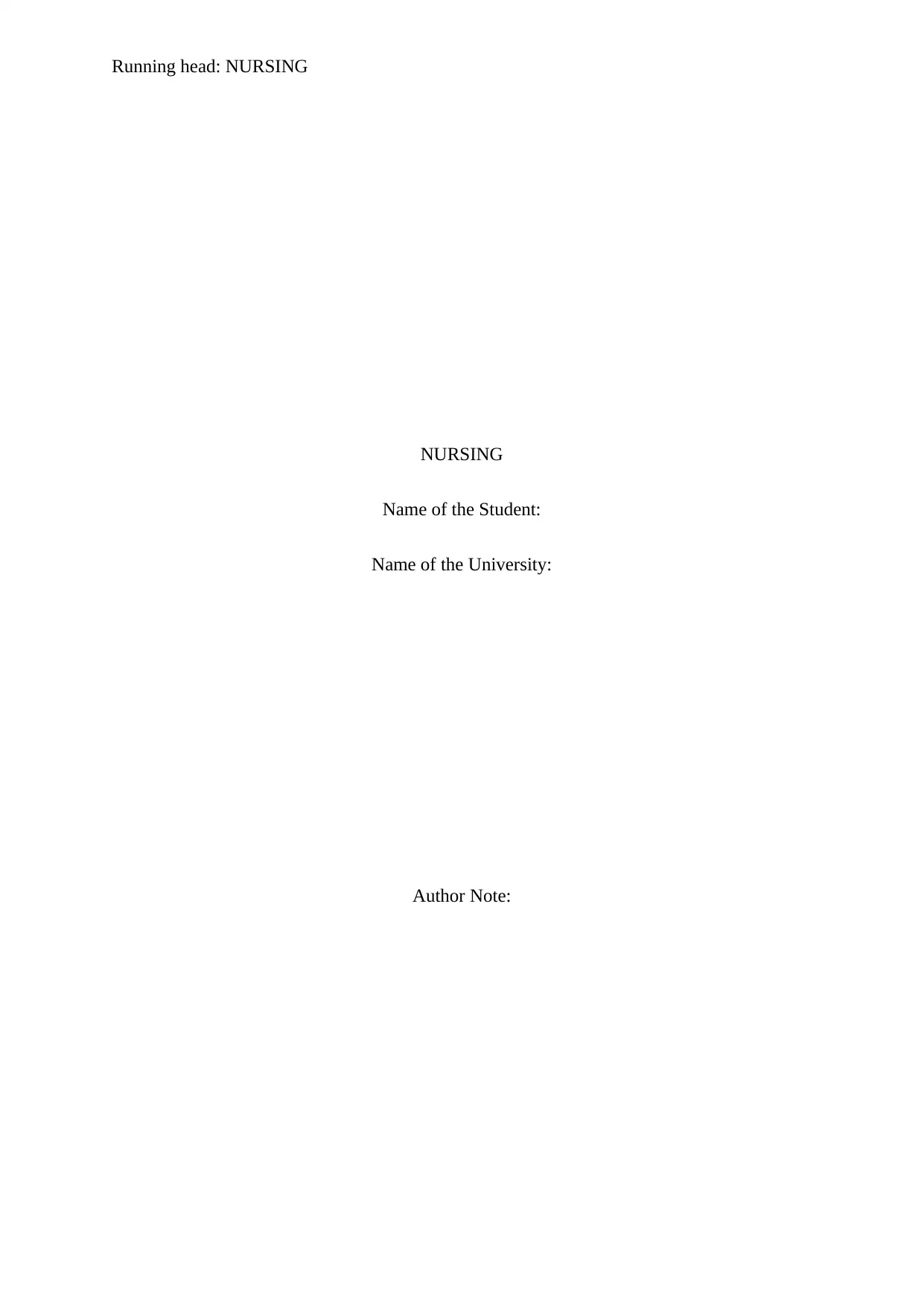
Running head: NURSING
NURSING
Name of the Student:
Name of the University:
Author Note:
NURSING
Name of the Student:
Name of the University:
Author Note:
Paraphrase This Document
Need a fresh take? Get an instant paraphrase of this document with our AI Paraphraser
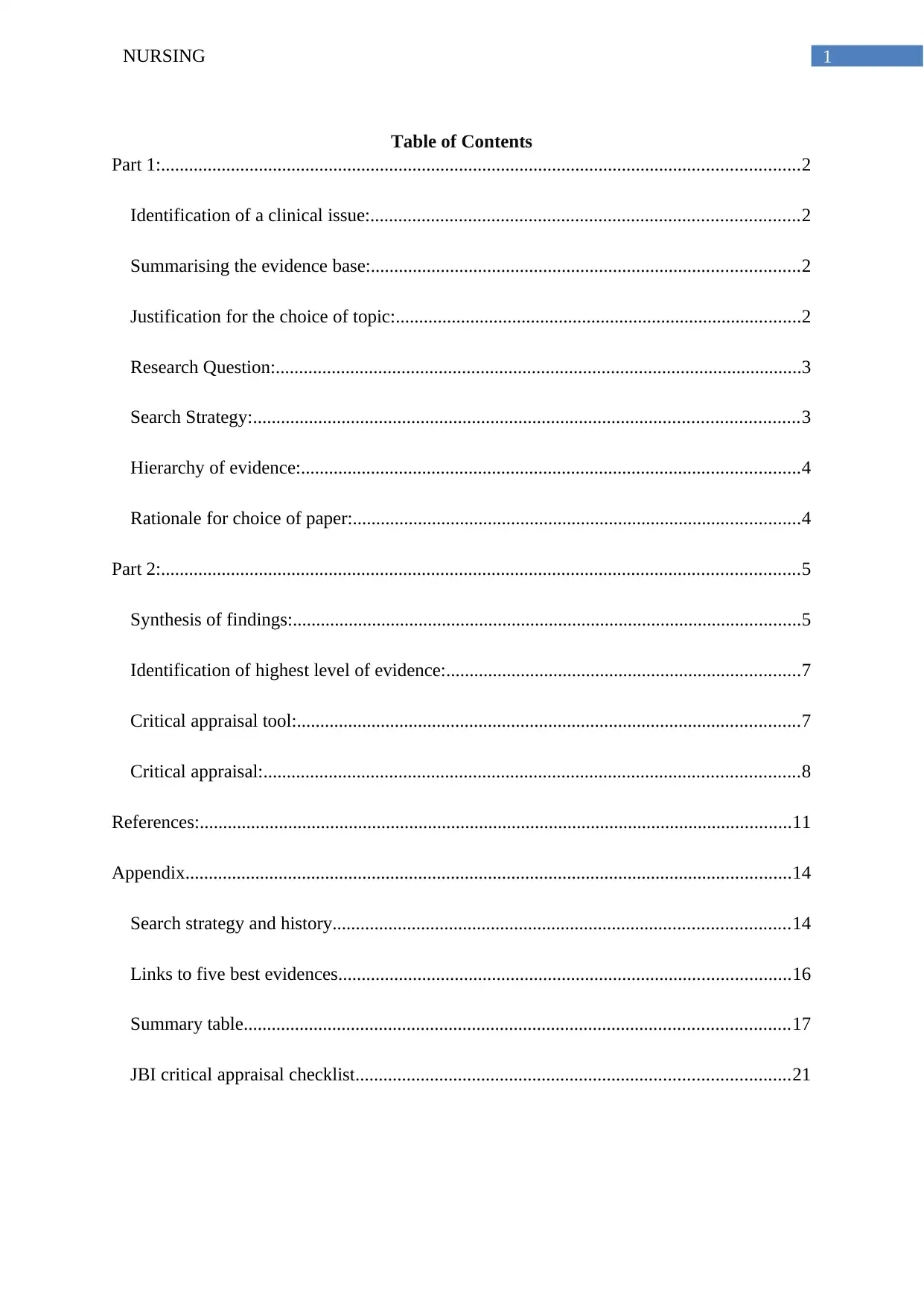
1NURSING
Table of Contents
Part 1:.........................................................................................................................................2
Identification of a clinical issue:............................................................................................2
Summarising the evidence base:............................................................................................2
Justification for the choice of topic:.......................................................................................2
Research Question:.................................................................................................................3
Search Strategy:.....................................................................................................................3
Hierarchy of evidence:...........................................................................................................4
Rationale for choice of paper:................................................................................................4
Part 2:.........................................................................................................................................5
Synthesis of findings:.............................................................................................................5
Identification of highest level of evidence:............................................................................7
Critical appraisal tool:............................................................................................................7
Critical appraisal:...................................................................................................................8
References:...............................................................................................................................11
Appendix..................................................................................................................................14
Search strategy and history..................................................................................................14
Links to five best evidences.................................................................................................16
Summary table.....................................................................................................................17
JBI critical appraisal checklist.............................................................................................21
Table of Contents
Part 1:.........................................................................................................................................2
Identification of a clinical issue:............................................................................................2
Summarising the evidence base:............................................................................................2
Justification for the choice of topic:.......................................................................................2
Research Question:.................................................................................................................3
Search Strategy:.....................................................................................................................3
Hierarchy of evidence:...........................................................................................................4
Rationale for choice of paper:................................................................................................4
Part 2:.........................................................................................................................................5
Synthesis of findings:.............................................................................................................5
Identification of highest level of evidence:............................................................................7
Critical appraisal tool:............................................................................................................7
Critical appraisal:...................................................................................................................8
References:...............................................................................................................................11
Appendix..................................................................................................................................14
Search strategy and history..................................................................................................14
Links to five best evidences.................................................................................................16
Summary table.....................................................................................................................17
JBI critical appraisal checklist.............................................................................................21
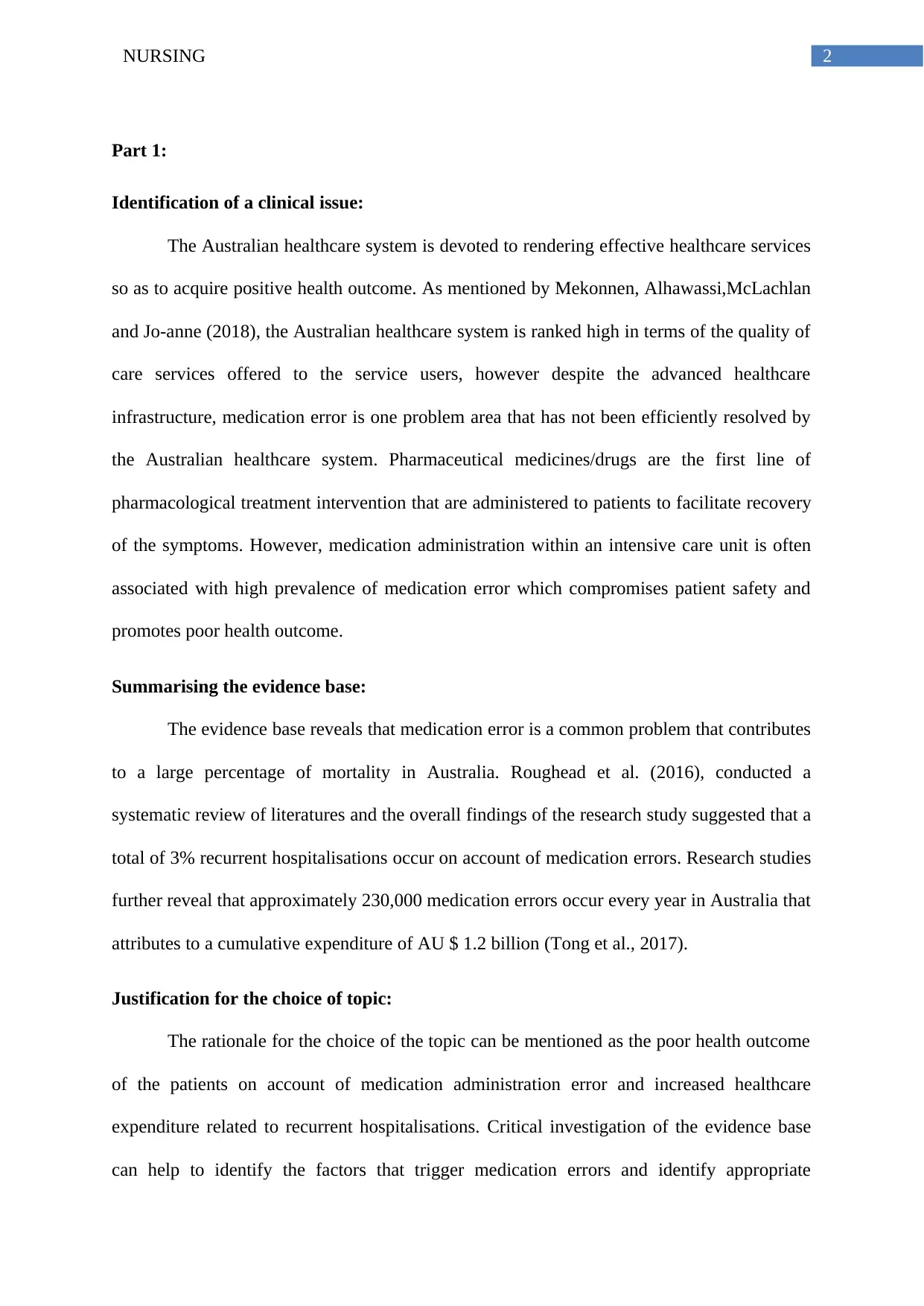
2NURSING
Part 1:
Identification of a clinical issue:
The Australian healthcare system is devoted to rendering effective healthcare services
so as to acquire positive health outcome. As mentioned by Mekonnen, Alhawassi,McLachlan
and Jo-anne (2018), the Australian healthcare system is ranked high in terms of the quality of
care services offered to the service users, however despite the advanced healthcare
infrastructure, medication error is one problem area that has not been efficiently resolved by
the Australian healthcare system. Pharmaceutical medicines/drugs are the first line of
pharmacological treatment intervention that are administered to patients to facilitate recovery
of the symptoms. However, medication administration within an intensive care unit is often
associated with high prevalence of medication error which compromises patient safety and
promotes poor health outcome.
Summarising the evidence base:
The evidence base reveals that medication error is a common problem that contributes
to a large percentage of mortality in Australia. Roughead et al. (2016), conducted a
systematic review of literatures and the overall findings of the research study suggested that a
total of 3% recurrent hospitalisations occur on account of medication errors. Research studies
further reveal that approximately 230,000 medication errors occur every year in Australia that
attributes to a cumulative expenditure of AU $ 1.2 billion (Tong et al., 2017).
Justification for the choice of topic:
The rationale for the choice of the topic can be mentioned as the poor health outcome
of the patients on account of medication administration error and increased healthcare
expenditure related to recurrent hospitalisations. Critical investigation of the evidence base
can help to identify the factors that trigger medication errors and identify appropriate
Part 1:
Identification of a clinical issue:
The Australian healthcare system is devoted to rendering effective healthcare services
so as to acquire positive health outcome. As mentioned by Mekonnen, Alhawassi,McLachlan
and Jo-anne (2018), the Australian healthcare system is ranked high in terms of the quality of
care services offered to the service users, however despite the advanced healthcare
infrastructure, medication error is one problem area that has not been efficiently resolved by
the Australian healthcare system. Pharmaceutical medicines/drugs are the first line of
pharmacological treatment intervention that are administered to patients to facilitate recovery
of the symptoms. However, medication administration within an intensive care unit is often
associated with high prevalence of medication error which compromises patient safety and
promotes poor health outcome.
Summarising the evidence base:
The evidence base reveals that medication error is a common problem that contributes
to a large percentage of mortality in Australia. Roughead et al. (2016), conducted a
systematic review of literatures and the overall findings of the research study suggested that a
total of 3% recurrent hospitalisations occur on account of medication errors. Research studies
further reveal that approximately 230,000 medication errors occur every year in Australia that
attributes to a cumulative expenditure of AU $ 1.2 billion (Tong et al., 2017).
Justification for the choice of topic:
The rationale for the choice of the topic can be mentioned as the poor health outcome
of the patients on account of medication administration error and increased healthcare
expenditure related to recurrent hospitalisations. Critical investigation of the evidence base
can help to identify the factors that trigger medication errors and identify appropriate
⊘ This is a preview!⊘
Do you want full access?
Subscribe today to unlock all pages.

Trusted by 1+ million students worldwide
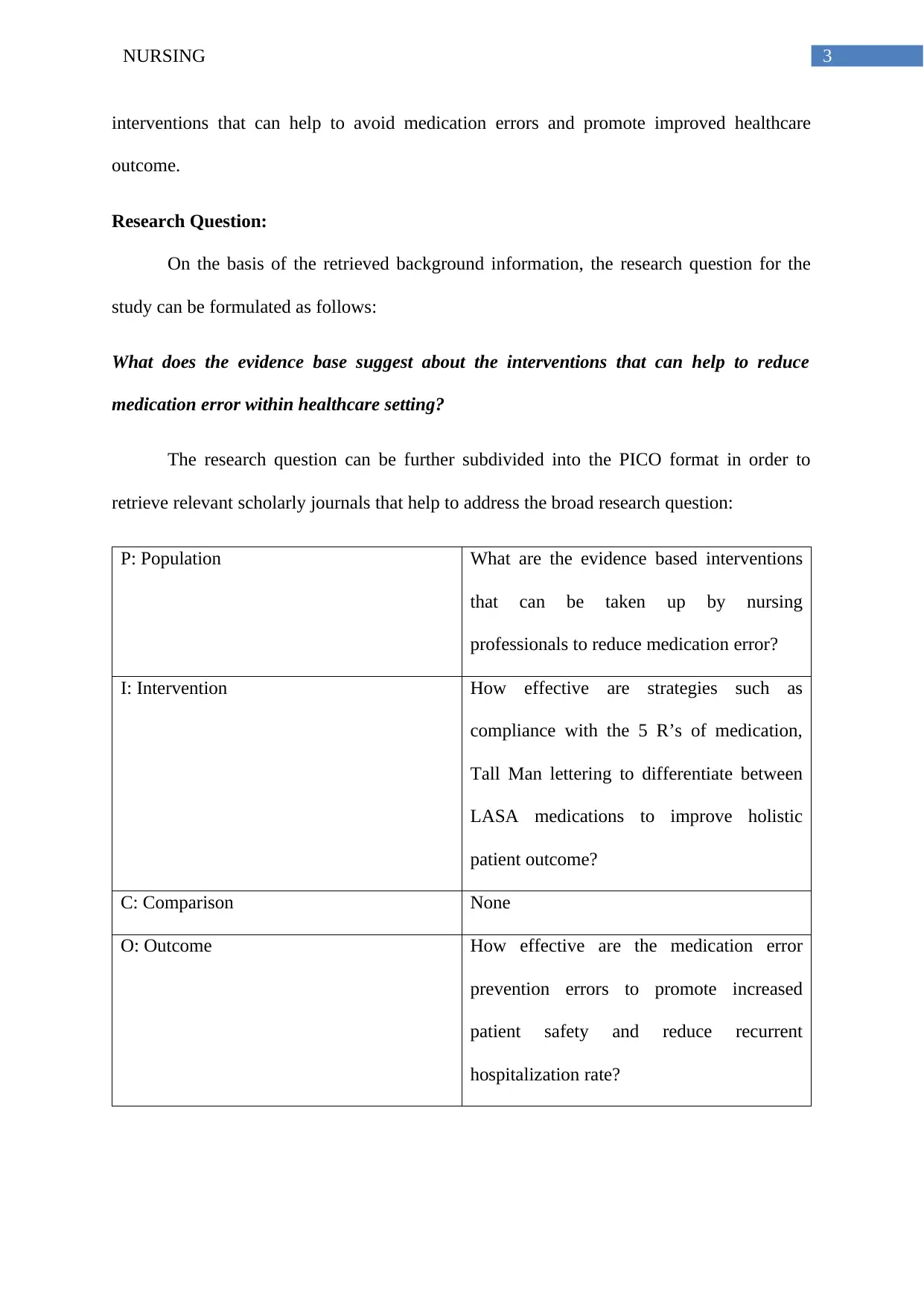
3NURSING
interventions that can help to avoid medication errors and promote improved healthcare
outcome.
Research Question:
On the basis of the retrieved background information, the research question for the
study can be formulated as follows:
What does the evidence base suggest about the interventions that can help to reduce
medication error within healthcare setting?
The research question can be further subdivided into the PICO format in order to
retrieve relevant scholarly journals that help to address the broad research question:
P: Population What are the evidence based interventions
that can be taken up by nursing
professionals to reduce medication error?
I: Intervention How effective are strategies such as
compliance with the 5 R’s of medication,
Tall Man lettering to differentiate between
LASA medications to improve holistic
patient outcome?
C: Comparison None
O: Outcome How effective are the medication error
prevention errors to promote increased
patient safety and reduce recurrent
hospitalization rate?
interventions that can help to avoid medication errors and promote improved healthcare
outcome.
Research Question:
On the basis of the retrieved background information, the research question for the
study can be formulated as follows:
What does the evidence base suggest about the interventions that can help to reduce
medication error within healthcare setting?
The research question can be further subdivided into the PICO format in order to
retrieve relevant scholarly journals that help to address the broad research question:
P: Population What are the evidence based interventions
that can be taken up by nursing
professionals to reduce medication error?
I: Intervention How effective are strategies such as
compliance with the 5 R’s of medication,
Tall Man lettering to differentiate between
LASA medications to improve holistic
patient outcome?
C: Comparison None
O: Outcome How effective are the medication error
prevention errors to promote increased
patient safety and reduce recurrent
hospitalization rate?
Paraphrase This Document
Need a fresh take? Get an instant paraphrase of this document with our AI Paraphraser
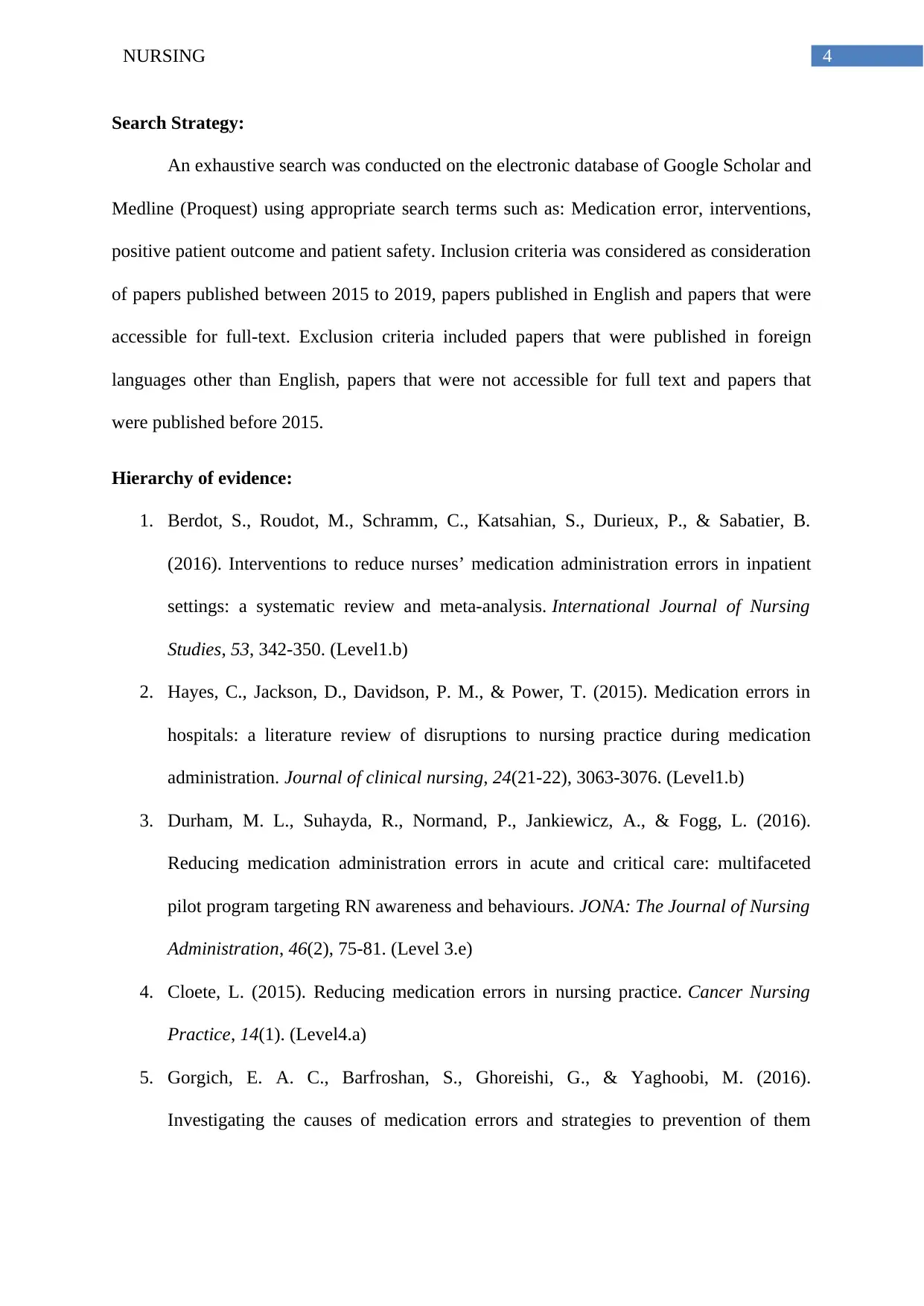
4NURSING
Search Strategy:
An exhaustive search was conducted on the electronic database of Google Scholar and
Medline (Proquest) using appropriate search terms such as: Medication error, interventions,
positive patient outcome and patient safety. Inclusion criteria was considered as consideration
of papers published between 2015 to 2019, papers published in English and papers that were
accessible for full-text. Exclusion criteria included papers that were published in foreign
languages other than English, papers that were not accessible for full text and papers that
were published before 2015.
Hierarchy of evidence:
1. Berdot, S., Roudot, M., Schramm, C., Katsahian, S., Durieux, P., & Sabatier, B.
(2016). Interventions to reduce nurses’ medication administration errors in inpatient
settings: a systematic review and meta-analysis. International Journal of Nursing
Studies, 53, 342-350. (Level1.b)
2. Hayes, C., Jackson, D., Davidson, P. M., & Power, T. (2015). Medication errors in
hospitals: a literature review of disruptions to nursing practice during medication
administration. Journal of clinical nursing, 24(21-22), 3063-3076. (Level1.b)
3. Durham, M. L., Suhayda, R., Normand, P., Jankiewicz, A., & Fogg, L. (2016).
Reducing medication administration errors in acute and critical care: multifaceted
pilot program targeting RN awareness and behaviours. JONA: The Journal of Nursing
Administration, 46(2), 75-81. (Level 3.e)
4. Cloete, L. (2015). Reducing medication errors in nursing practice. Cancer Nursing
Practice, 14(1). (Level4.a)
5. Gorgich, E. A. C., Barfroshan, S., Ghoreishi, G., & Yaghoobi, M. (2016).
Investigating the causes of medication errors and strategies to prevention of them
Search Strategy:
An exhaustive search was conducted on the electronic database of Google Scholar and
Medline (Proquest) using appropriate search terms such as: Medication error, interventions,
positive patient outcome and patient safety. Inclusion criteria was considered as consideration
of papers published between 2015 to 2019, papers published in English and papers that were
accessible for full-text. Exclusion criteria included papers that were published in foreign
languages other than English, papers that were not accessible for full text and papers that
were published before 2015.
Hierarchy of evidence:
1. Berdot, S., Roudot, M., Schramm, C., Katsahian, S., Durieux, P., & Sabatier, B.
(2016). Interventions to reduce nurses’ medication administration errors in inpatient
settings: a systematic review and meta-analysis. International Journal of Nursing
Studies, 53, 342-350. (Level1.b)
2. Hayes, C., Jackson, D., Davidson, P. M., & Power, T. (2015). Medication errors in
hospitals: a literature review of disruptions to nursing practice during medication
administration. Journal of clinical nursing, 24(21-22), 3063-3076. (Level1.b)
3. Durham, M. L., Suhayda, R., Normand, P., Jankiewicz, A., & Fogg, L. (2016).
Reducing medication administration errors in acute and critical care: multifaceted
pilot program targeting RN awareness and behaviours. JONA: The Journal of Nursing
Administration, 46(2), 75-81. (Level 3.e)
4. Cloete, L. (2015). Reducing medication errors in nursing practice. Cancer Nursing
Practice, 14(1). (Level4.a)
5. Gorgich, E. A. C., Barfroshan, S., Ghoreishi, G., & Yaghoobi, M. (2016).
Investigating the causes of medication errors and strategies to prevention of them
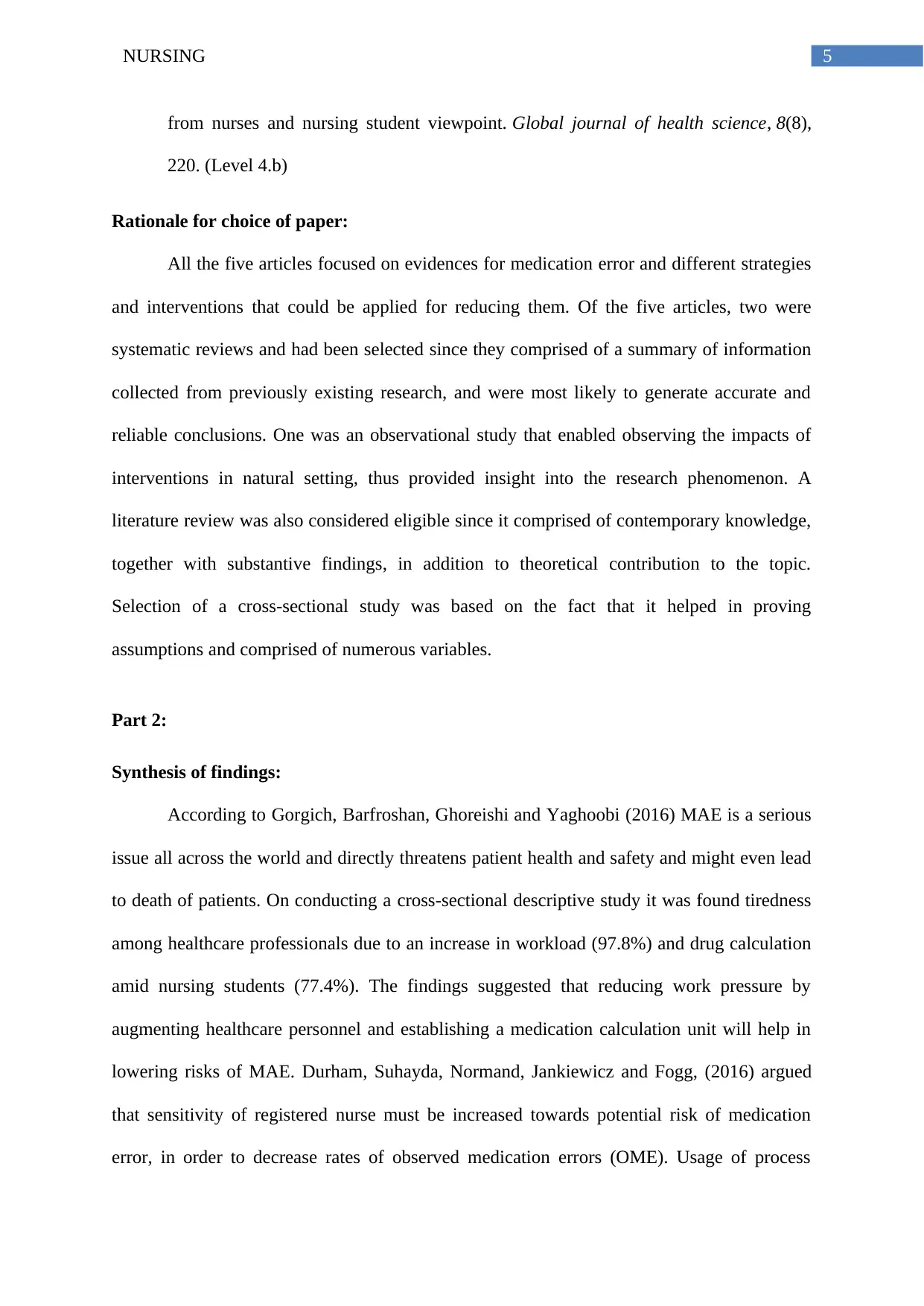
5NURSING
from nurses and nursing student viewpoint. Global journal of health science, 8(8),
220. (Level 4.b)
Rationale for choice of paper:
All the five articles focused on evidences for medication error and different strategies
and interventions that could be applied for reducing them. Of the five articles, two were
systematic reviews and had been selected since they comprised of a summary of information
collected from previously existing research, and were most likely to generate accurate and
reliable conclusions. One was an observational study that enabled observing the impacts of
interventions in natural setting, thus provided insight into the research phenomenon. A
literature review was also considered eligible since it comprised of contemporary knowledge,
together with substantive findings, in addition to theoretical contribution to the topic.
Selection of a cross-sectional study was based on the fact that it helped in proving
assumptions and comprised of numerous variables.
Part 2:
Synthesis of findings:
According to Gorgich, Barfroshan, Ghoreishi and Yaghoobi (2016) MAE is a serious
issue all across the world and directly threatens patient health and safety and might even lead
to death of patients. On conducting a cross-sectional descriptive study it was found tiredness
among healthcare professionals due to an increase in workload (97.8%) and drug calculation
amid nursing students (77.4%). The findings suggested that reducing work pressure by
augmenting healthcare personnel and establishing a medication calculation unit will help in
lowering risks of MAE. Durham, Suhayda, Normand, Jankiewicz and Fogg, (2016) argued
that sensitivity of registered nurse must be increased towards potential risk of medication
error, in order to decrease rates of observed medication errors (OME). Usage of process
from nurses and nursing student viewpoint. Global journal of health science, 8(8),
220. (Level 4.b)
Rationale for choice of paper:
All the five articles focused on evidences for medication error and different strategies
and interventions that could be applied for reducing them. Of the five articles, two were
systematic reviews and had been selected since they comprised of a summary of information
collected from previously existing research, and were most likely to generate accurate and
reliable conclusions. One was an observational study that enabled observing the impacts of
interventions in natural setting, thus provided insight into the research phenomenon. A
literature review was also considered eligible since it comprised of contemporary knowledge,
together with substantive findings, in addition to theoretical contribution to the topic.
Selection of a cross-sectional study was based on the fact that it helped in proving
assumptions and comprised of numerous variables.
Part 2:
Synthesis of findings:
According to Gorgich, Barfroshan, Ghoreishi and Yaghoobi (2016) MAE is a serious
issue all across the world and directly threatens patient health and safety and might even lead
to death of patients. On conducting a cross-sectional descriptive study it was found tiredness
among healthcare professionals due to an increase in workload (97.8%) and drug calculation
amid nursing students (77.4%). The findings suggested that reducing work pressure by
augmenting healthcare personnel and establishing a medication calculation unit will help in
lowering risks of MAE. Durham, Suhayda, Normand, Jankiewicz and Fogg, (2016) argued
that sensitivity of registered nurse must be increased towards potential risk of medication
error, in order to decrease rates of observed medication errors (OME). Usage of process
⊘ This is a preview!⊘
Do you want full access?
Subscribe today to unlock all pages.

Trusted by 1+ million students worldwide
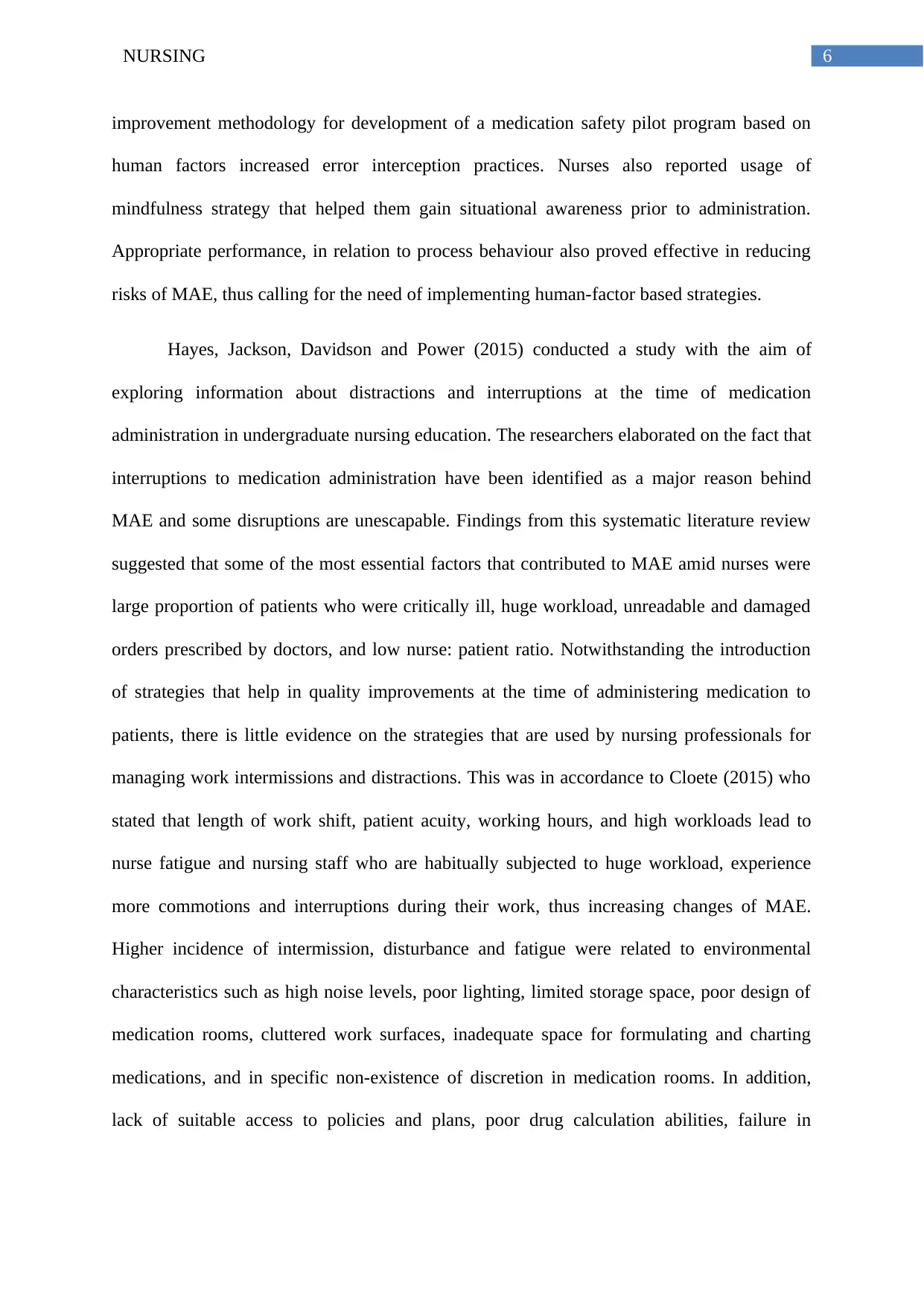
6NURSING
improvement methodology for development of a medication safety pilot program based on
human factors increased error interception practices. Nurses also reported usage of
mindfulness strategy that helped them gain situational awareness prior to administration.
Appropriate performance, in relation to process behaviour also proved effective in reducing
risks of MAE, thus calling for the need of implementing human-factor based strategies.
Hayes, Jackson, Davidson and Power (2015) conducted a study with the aim of
exploring information about distractions and interruptions at the time of medication
administration in undergraduate nursing education. The researchers elaborated on the fact that
interruptions to medication administration have been identified as a major reason behind
MAE and some disruptions are unescapable. Findings from this systematic literature review
suggested that some of the most essential factors that contributed to MAE amid nurses were
large proportion of patients who were critically ill, huge workload, unreadable and damaged
orders prescribed by doctors, and low nurse: patient ratio. Notwithstanding the introduction
of strategies that help in quality improvements at the time of administering medication to
patients, there is little evidence on the strategies that are used by nursing professionals for
managing work intermissions and distractions. This was in accordance to Cloete (2015) who
stated that length of work shift, patient acuity, working hours, and high workloads lead to
nurse fatigue and nursing staff who are habitually subjected to huge workload, experience
more commotions and interruptions during their work, thus increasing changes of MAE.
Higher incidence of intermission, disturbance and fatigue were related to environmental
characteristics such as high noise levels, poor lighting, limited storage space, poor design of
medication rooms, cluttered work surfaces, inadequate space for formulating and charting
medications, and in specific non-existence of discretion in medication rooms. In addition,
lack of suitable access to policies and plans, poor drug calculation abilities, failure in
improvement methodology for development of a medication safety pilot program based on
human factors increased error interception practices. Nurses also reported usage of
mindfulness strategy that helped them gain situational awareness prior to administration.
Appropriate performance, in relation to process behaviour also proved effective in reducing
risks of MAE, thus calling for the need of implementing human-factor based strategies.
Hayes, Jackson, Davidson and Power (2015) conducted a study with the aim of
exploring information about distractions and interruptions at the time of medication
administration in undergraduate nursing education. The researchers elaborated on the fact that
interruptions to medication administration have been identified as a major reason behind
MAE and some disruptions are unescapable. Findings from this systematic literature review
suggested that some of the most essential factors that contributed to MAE amid nurses were
large proportion of patients who were critically ill, huge workload, unreadable and damaged
orders prescribed by doctors, and low nurse: patient ratio. Notwithstanding the introduction
of strategies that help in quality improvements at the time of administering medication to
patients, there is little evidence on the strategies that are used by nursing professionals for
managing work intermissions and distractions. This was in accordance to Cloete (2015) who
stated that length of work shift, patient acuity, working hours, and high workloads lead to
nurse fatigue and nursing staff who are habitually subjected to huge workload, experience
more commotions and interruptions during their work, thus increasing changes of MAE.
Higher incidence of intermission, disturbance and fatigue were related to environmental
characteristics such as high noise levels, poor lighting, limited storage space, poor design of
medication rooms, cluttered work surfaces, inadequate space for formulating and charting
medications, and in specific non-existence of discretion in medication rooms. In addition,
lack of suitable access to policies and plans, poor drug calculation abilities, failure in
Paraphrase This Document
Need a fresh take? Get an instant paraphrase of this document with our AI Paraphraser
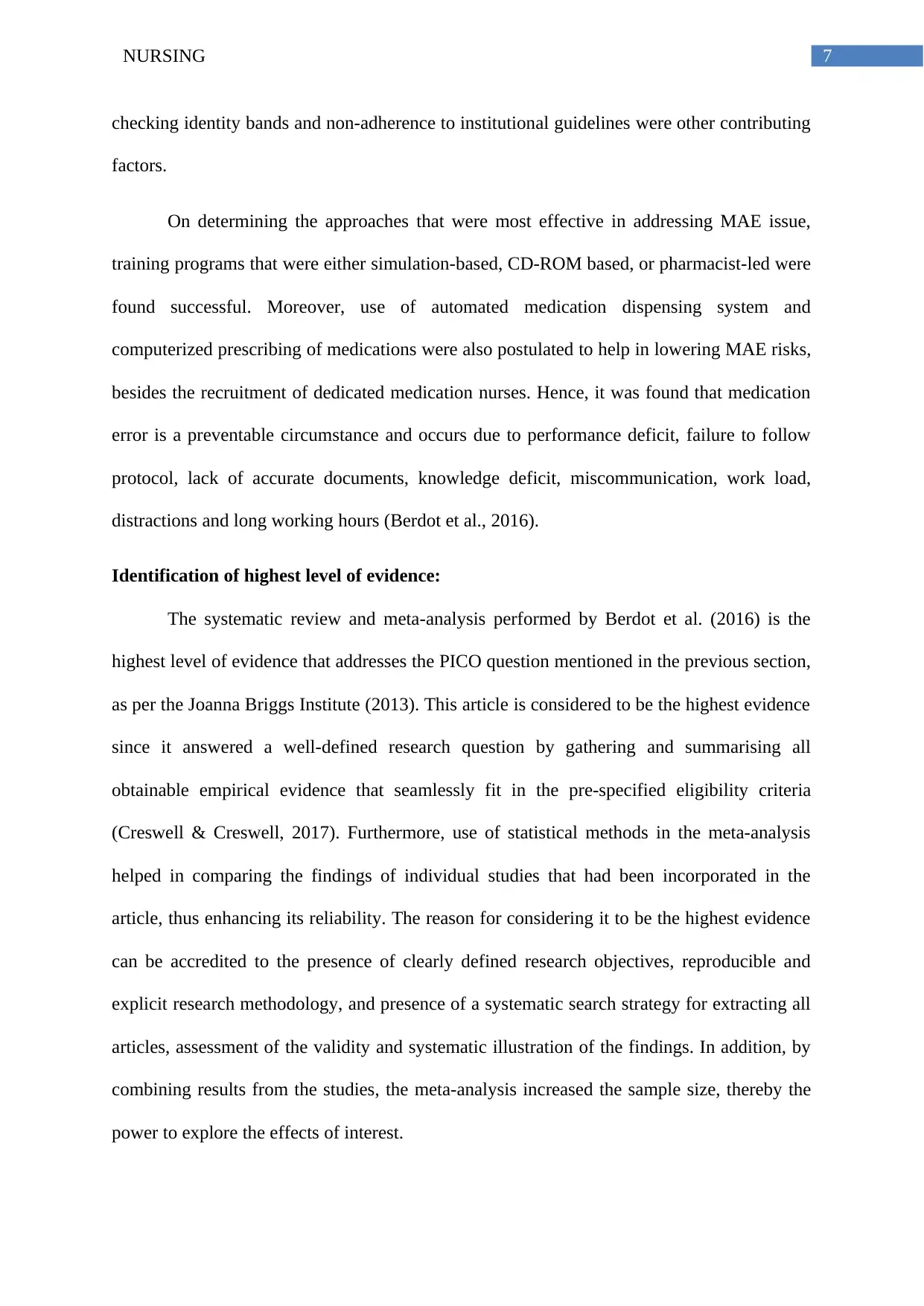
7NURSING
checking identity bands and non-adherence to institutional guidelines were other contributing
factors.
On determining the approaches that were most effective in addressing MAE issue,
training programs that were either simulation-based, CD-ROM based, or pharmacist-led were
found successful. Moreover, use of automated medication dispensing system and
computerized prescribing of medications were also postulated to help in lowering MAE risks,
besides the recruitment of dedicated medication nurses. Hence, it was found that medication
error is a preventable circumstance and occurs due to performance deficit, failure to follow
protocol, lack of accurate documents, knowledge deficit, miscommunication, work load,
distractions and long working hours (Berdot et al., 2016).
Identification of highest level of evidence:
The systematic review and meta-analysis performed by Berdot et al. (2016) is the
highest level of evidence that addresses the PICO question mentioned in the previous section,
as per the Joanna Briggs Institute (2013). This article is considered to be the highest evidence
since it answered a well-defined research question by gathering and summarising all
obtainable empirical evidence that seamlessly fit in the pre-specified eligibility criteria
(Creswell & Creswell, 2017). Furthermore, use of statistical methods in the meta-analysis
helped in comparing the findings of individual studies that had been incorporated in the
article, thus enhancing its reliability. The reason for considering it to be the highest evidence
can be accredited to the presence of clearly defined research objectives, reproducible and
explicit research methodology, and presence of a systematic search strategy for extracting all
articles, assessment of the validity and systematic illustration of the findings. In addition, by
combining results from the studies, the meta-analysis increased the sample size, thereby the
power to explore the effects of interest.
checking identity bands and non-adherence to institutional guidelines were other contributing
factors.
On determining the approaches that were most effective in addressing MAE issue,
training programs that were either simulation-based, CD-ROM based, or pharmacist-led were
found successful. Moreover, use of automated medication dispensing system and
computerized prescribing of medications were also postulated to help in lowering MAE risks,
besides the recruitment of dedicated medication nurses. Hence, it was found that medication
error is a preventable circumstance and occurs due to performance deficit, failure to follow
protocol, lack of accurate documents, knowledge deficit, miscommunication, work load,
distractions and long working hours (Berdot et al., 2016).
Identification of highest level of evidence:
The systematic review and meta-analysis performed by Berdot et al. (2016) is the
highest level of evidence that addresses the PICO question mentioned in the previous section,
as per the Joanna Briggs Institute (2013). This article is considered to be the highest evidence
since it answered a well-defined research question by gathering and summarising all
obtainable empirical evidence that seamlessly fit in the pre-specified eligibility criteria
(Creswell & Creswell, 2017). Furthermore, use of statistical methods in the meta-analysis
helped in comparing the findings of individual studies that had been incorporated in the
article, thus enhancing its reliability. The reason for considering it to be the highest evidence
can be accredited to the presence of clearly defined research objectives, reproducible and
explicit research methodology, and presence of a systematic search strategy for extracting all
articles, assessment of the validity and systematic illustration of the findings. In addition, by
combining results from the studies, the meta-analysis increased the sample size, thereby the
power to explore the effects of interest.
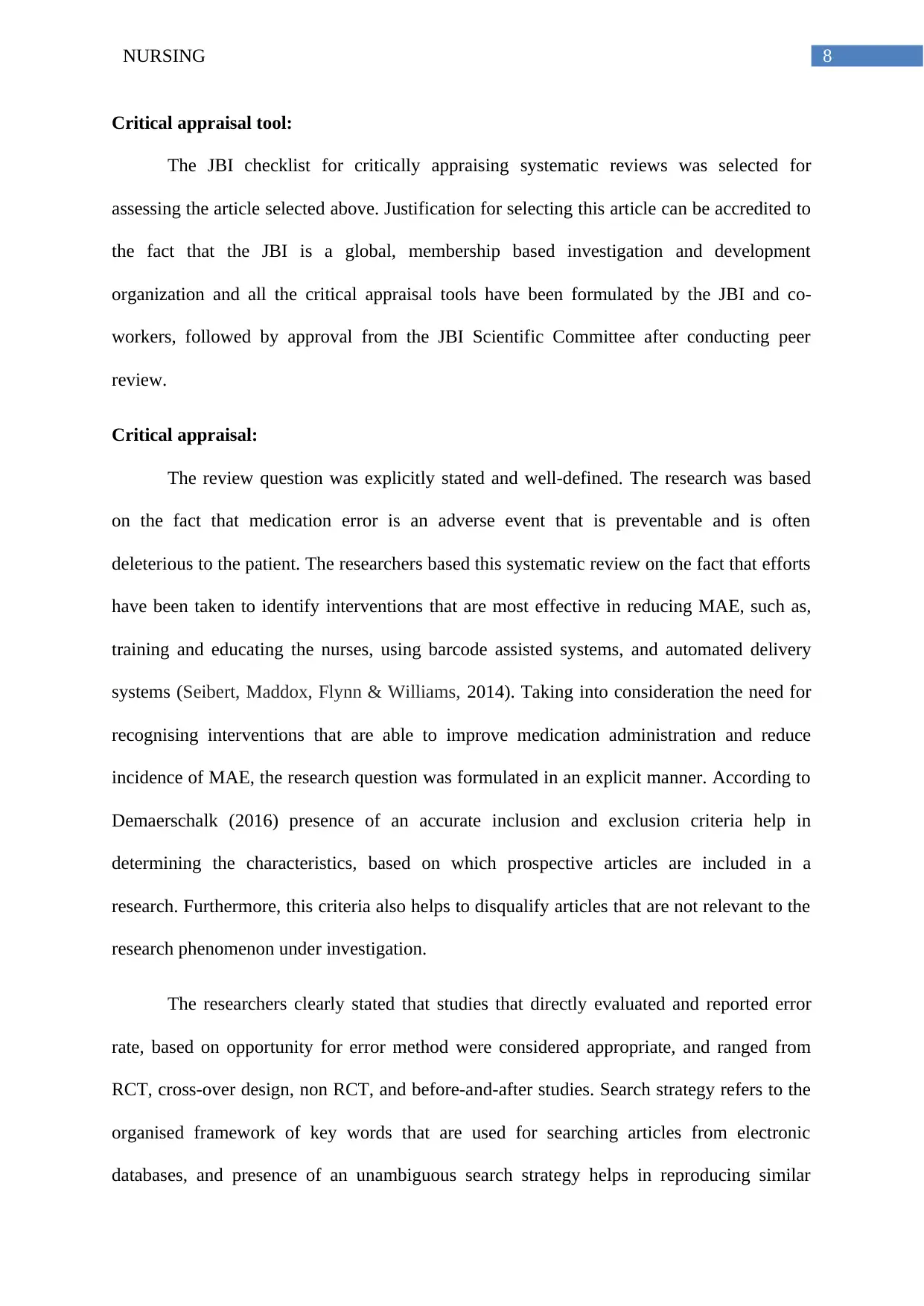
8NURSING
Critical appraisal tool:
The JBI checklist for critically appraising systematic reviews was selected for
assessing the article selected above. Justification for selecting this article can be accredited to
the fact that the JBI is a global, membership based investigation and development
organization and all the critical appraisal tools have been formulated by the JBI and co-
workers, followed by approval from the JBI Scientific Committee after conducting peer
review.
Critical appraisal:
The review question was explicitly stated and well-defined. The research was based
on the fact that medication error is an adverse event that is preventable and is often
deleterious to the patient. The researchers based this systematic review on the fact that efforts
have been taken to identify interventions that are most effective in reducing MAE, such as,
training and educating the nurses, using barcode assisted systems, and automated delivery
systems (Seibert, Maddox, Flynn & Williams, 2014). Taking into consideration the need for
recognising interventions that are able to improve medication administration and reduce
incidence of MAE, the research question was formulated in an explicit manner. According to
Demaerschalk (2016) presence of an accurate inclusion and exclusion criteria help in
determining the characteristics, based on which prospective articles are included in a
research. Furthermore, this criteria also helps to disqualify articles that are not relevant to the
research phenomenon under investigation.
The researchers clearly stated that studies that directly evaluated and reported error
rate, based on opportunity for error method were considered appropriate, and ranged from
RCT, cross-over design, non RCT, and before-and-after studies. Search strategy refers to the
organised framework of key words that are used for searching articles from electronic
databases, and presence of an unambiguous search strategy helps in reproducing similar
Critical appraisal tool:
The JBI checklist for critically appraising systematic reviews was selected for
assessing the article selected above. Justification for selecting this article can be accredited to
the fact that the JBI is a global, membership based investigation and development
organization and all the critical appraisal tools have been formulated by the JBI and co-
workers, followed by approval from the JBI Scientific Committee after conducting peer
review.
Critical appraisal:
The review question was explicitly stated and well-defined. The research was based
on the fact that medication error is an adverse event that is preventable and is often
deleterious to the patient. The researchers based this systematic review on the fact that efforts
have been taken to identify interventions that are most effective in reducing MAE, such as,
training and educating the nurses, using barcode assisted systems, and automated delivery
systems (Seibert, Maddox, Flynn & Williams, 2014). Taking into consideration the need for
recognising interventions that are able to improve medication administration and reduce
incidence of MAE, the research question was formulated in an explicit manner. According to
Demaerschalk (2016) presence of an accurate inclusion and exclusion criteria help in
determining the characteristics, based on which prospective articles are included in a
research. Furthermore, this criteria also helps to disqualify articles that are not relevant to the
research phenomenon under investigation.
The researchers clearly stated that studies that directly evaluated and reported error
rate, based on opportunity for error method were considered appropriate, and ranged from
RCT, cross-over design, non RCT, and before-and-after studies. Search strategy refers to the
organised framework of key words that are used for searching articles from electronic
databases, and presence of an unambiguous search strategy helps in reproducing similar
⊘ This is a preview!⊘
Do you want full access?
Subscribe today to unlock all pages.

Trusted by 1+ million students worldwide
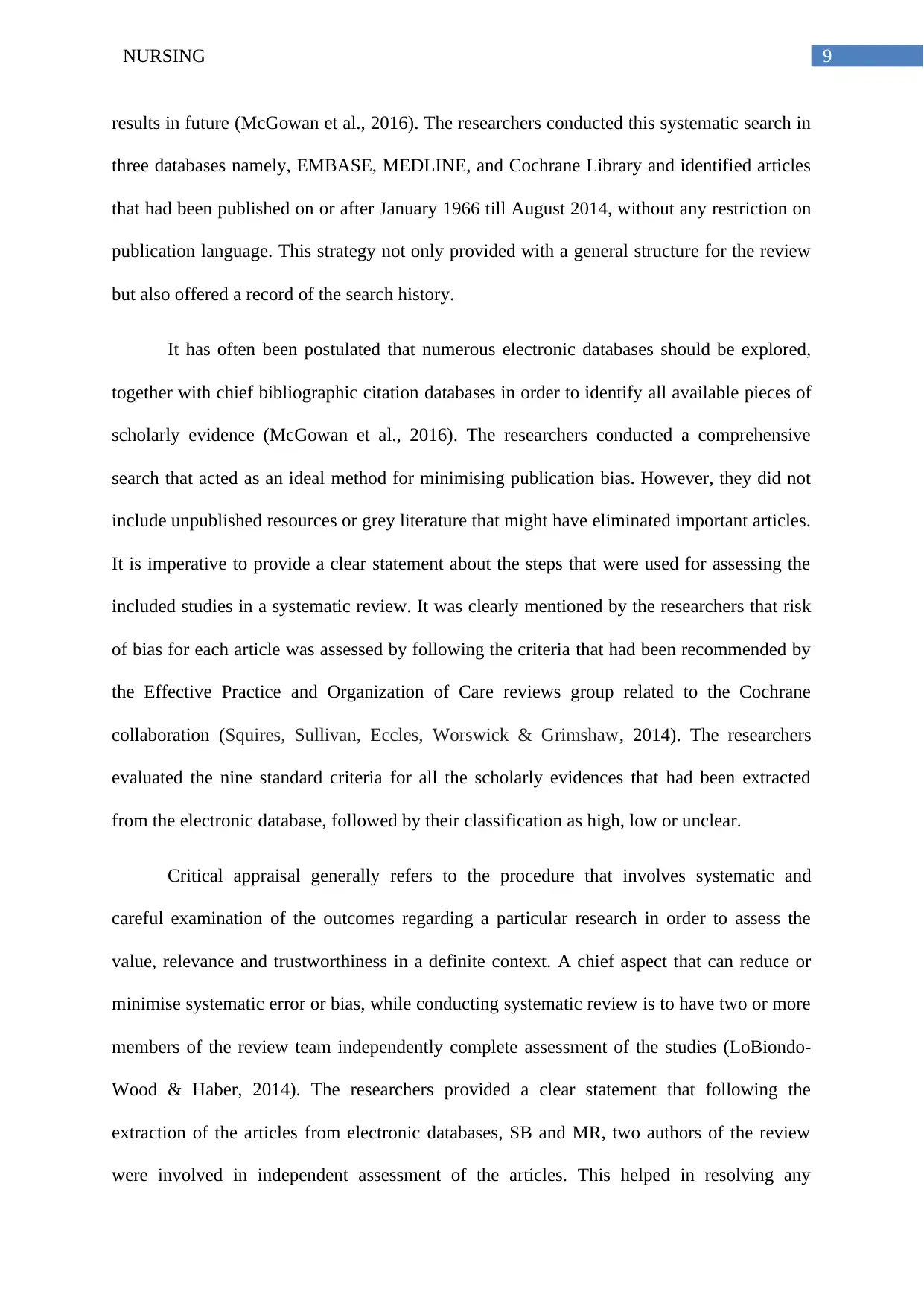
9NURSING
results in future (McGowan et al., 2016). The researchers conducted this systematic search in
three databases namely, EMBASE, MEDLINE, and Cochrane Library and identified articles
that had been published on or after January 1966 till August 2014, without any restriction on
publication language. This strategy not only provided with a general structure for the review
but also offered a record of the search history.
It has often been postulated that numerous electronic databases should be explored,
together with chief bibliographic citation databases in order to identify all available pieces of
scholarly evidence (McGowan et al., 2016). The researchers conducted a comprehensive
search that acted as an ideal method for minimising publication bias. However, they did not
include unpublished resources or grey literature that might have eliminated important articles.
It is imperative to provide a clear statement about the steps that were used for assessing the
included studies in a systematic review. It was clearly mentioned by the researchers that risk
of bias for each article was assessed by following the criteria that had been recommended by
the Effective Practice and Organization of Care reviews group related to the Cochrane
collaboration (Squires, Sullivan, Eccles, Worswick & Grimshaw, 2014). The researchers
evaluated the nine standard criteria for all the scholarly evidences that had been extracted
from the electronic database, followed by their classification as high, low or unclear.
Critical appraisal generally refers to the procedure that involves systematic and
careful examination of the outcomes regarding a particular research in order to assess the
value, relevance and trustworthiness in a definite context. A chief aspect that can reduce or
minimise systematic error or bias, while conducting systematic review is to have two or more
members of the review team independently complete assessment of the studies (LoBiondo-
Wood & Haber, 2014). The researchers provided a clear statement that following the
extraction of the articles from electronic databases, SB and MR, two authors of the review
were involved in independent assessment of the articles. This helped in resolving any
results in future (McGowan et al., 2016). The researchers conducted this systematic search in
three databases namely, EMBASE, MEDLINE, and Cochrane Library and identified articles
that had been published on or after January 1966 till August 2014, without any restriction on
publication language. This strategy not only provided with a general structure for the review
but also offered a record of the search history.
It has often been postulated that numerous electronic databases should be explored,
together with chief bibliographic citation databases in order to identify all available pieces of
scholarly evidence (McGowan et al., 2016). The researchers conducted a comprehensive
search that acted as an ideal method for minimising publication bias. However, they did not
include unpublished resources or grey literature that might have eliminated important articles.
It is imperative to provide a clear statement about the steps that were used for assessing the
included studies in a systematic review. It was clearly mentioned by the researchers that risk
of bias for each article was assessed by following the criteria that had been recommended by
the Effective Practice and Organization of Care reviews group related to the Cochrane
collaboration (Squires, Sullivan, Eccles, Worswick & Grimshaw, 2014). The researchers
evaluated the nine standard criteria for all the scholarly evidences that had been extracted
from the electronic database, followed by their classification as high, low or unclear.
Critical appraisal generally refers to the procedure that involves systematic and
careful examination of the outcomes regarding a particular research in order to assess the
value, relevance and trustworthiness in a definite context. A chief aspect that can reduce or
minimise systematic error or bias, while conducting systematic review is to have two or more
members of the review team independently complete assessment of the studies (LoBiondo-
Wood & Haber, 2014). The researchers provided a clear statement that following the
extraction of the articles from electronic databases, SB and MR, two authors of the review
were involved in independent assessment of the articles. This helped in resolving any
Paraphrase This Document
Need a fresh take? Get an instant paraphrase of this document with our AI Paraphraser
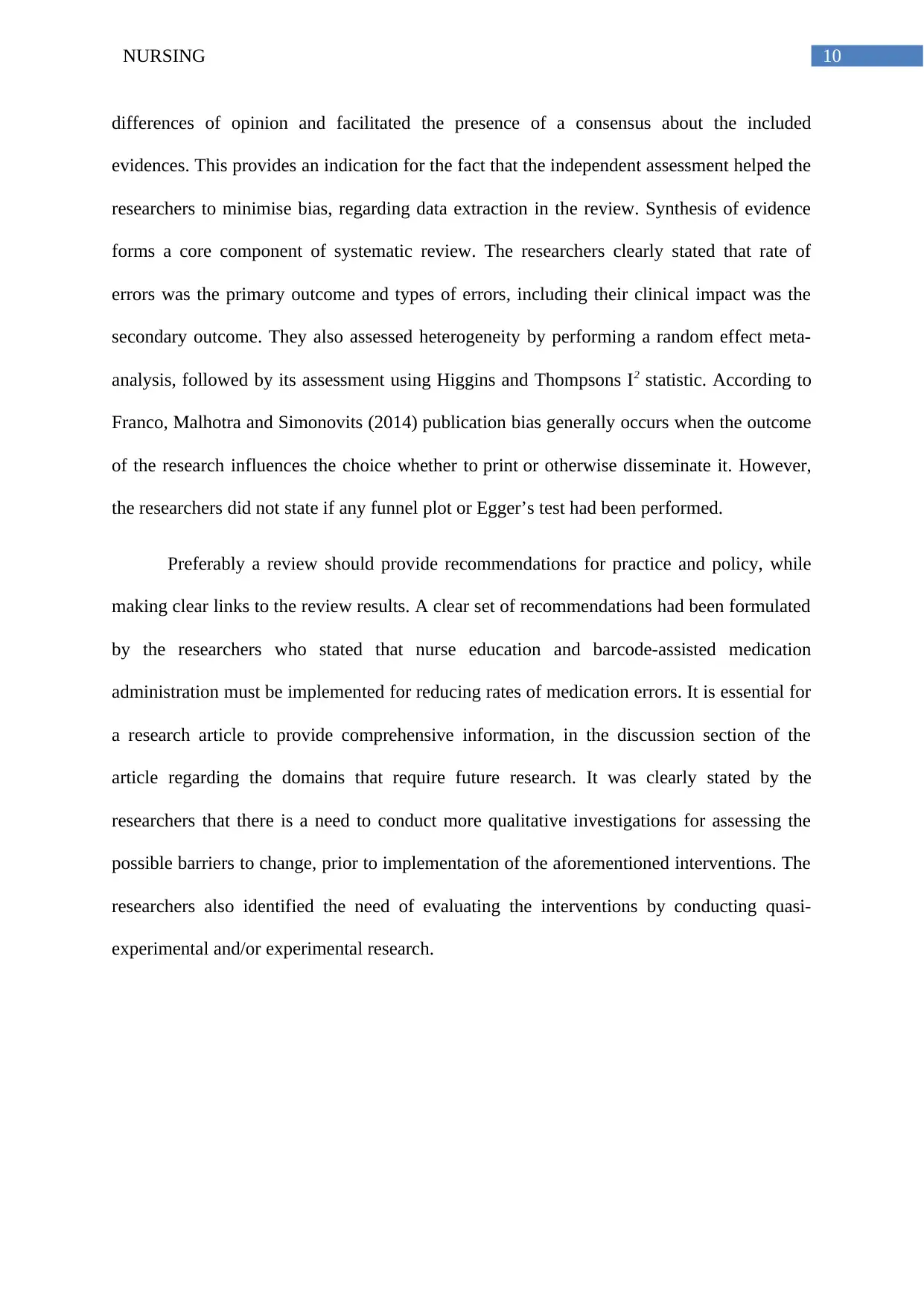
10NURSING
differences of opinion and facilitated the presence of a consensus about the included
evidences. This provides an indication for the fact that the independent assessment helped the
researchers to minimise bias, regarding data extraction in the review. Synthesis of evidence
forms a core component of systematic review. The researchers clearly stated that rate of
errors was the primary outcome and types of errors, including their clinical impact was the
secondary outcome. They also assessed heterogeneity by performing a random effect meta-
analysis, followed by its assessment using Higgins and Thompsons I2 statistic. According to
Franco, Malhotra and Simonovits (2014) publication bias generally occurs when the outcome
of the research influences the choice whether to print or otherwise disseminate it. However,
the researchers did not state if any funnel plot or Egger’s test had been performed.
Preferably a review should provide recommendations for practice and policy, while
making clear links to the review results. A clear set of recommendations had been formulated
by the researchers who stated that nurse education and barcode-assisted medication
administration must be implemented for reducing rates of medication errors. It is essential for
a research article to provide comprehensive information, in the discussion section of the
article regarding the domains that require future research. It was clearly stated by the
researchers that there is a need to conduct more qualitative investigations for assessing the
possible barriers to change, prior to implementation of the aforementioned interventions. The
researchers also identified the need of evaluating the interventions by conducting quasi-
experimental and/or experimental research.
differences of opinion and facilitated the presence of a consensus about the included
evidences. This provides an indication for the fact that the independent assessment helped the
researchers to minimise bias, regarding data extraction in the review. Synthesis of evidence
forms a core component of systematic review. The researchers clearly stated that rate of
errors was the primary outcome and types of errors, including their clinical impact was the
secondary outcome. They also assessed heterogeneity by performing a random effect meta-
analysis, followed by its assessment using Higgins and Thompsons I2 statistic. According to
Franco, Malhotra and Simonovits (2014) publication bias generally occurs when the outcome
of the research influences the choice whether to print or otherwise disseminate it. However,
the researchers did not state if any funnel plot or Egger’s test had been performed.
Preferably a review should provide recommendations for practice and policy, while
making clear links to the review results. A clear set of recommendations had been formulated
by the researchers who stated that nurse education and barcode-assisted medication
administration must be implemented for reducing rates of medication errors. It is essential for
a research article to provide comprehensive information, in the discussion section of the
article regarding the domains that require future research. It was clearly stated by the
researchers that there is a need to conduct more qualitative investigations for assessing the
possible barriers to change, prior to implementation of the aforementioned interventions. The
researchers also identified the need of evaluating the interventions by conducting quasi-
experimental and/or experimental research.
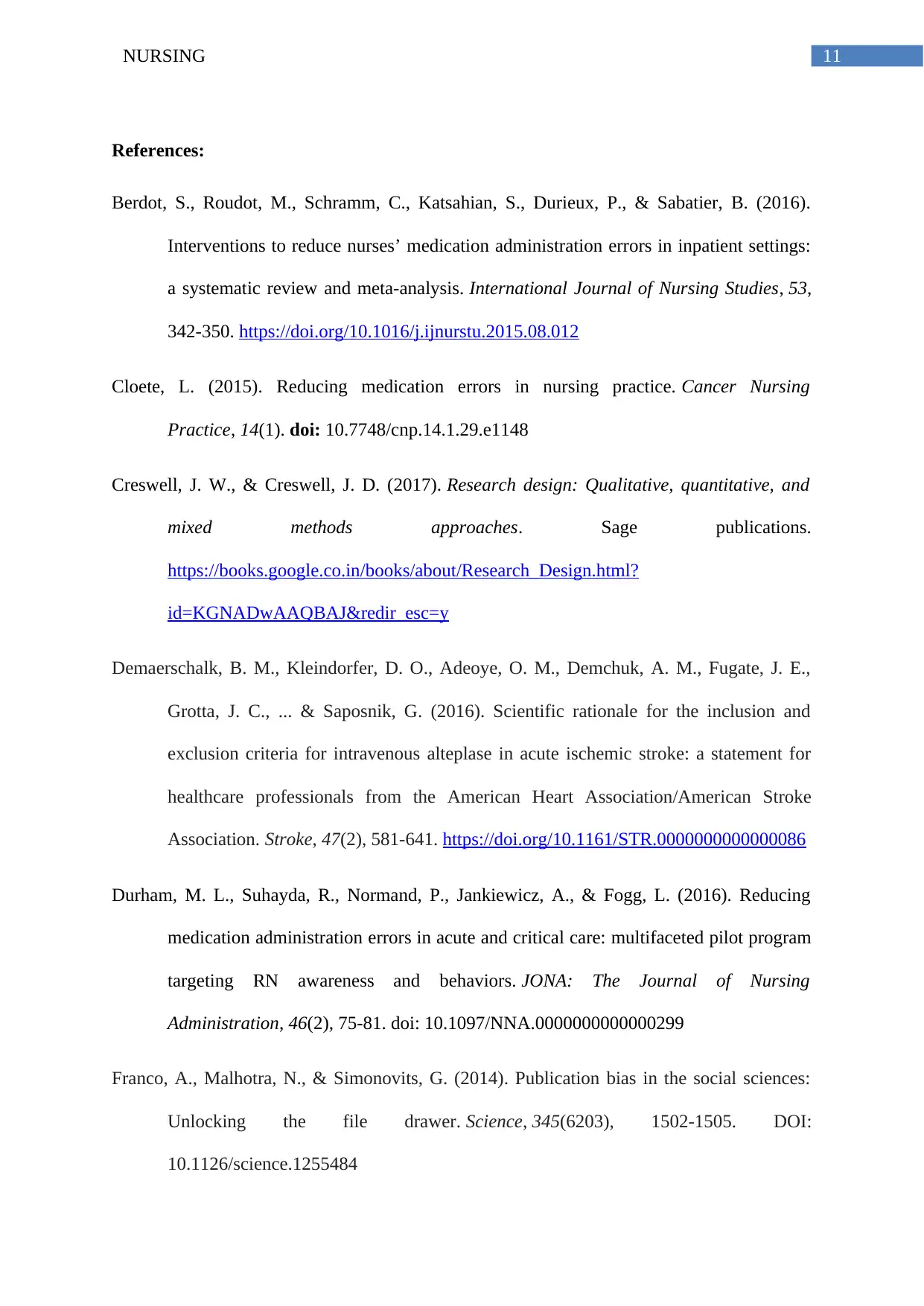
11NURSING
References:
Berdot, S., Roudot, M., Schramm, C., Katsahian, S., Durieux, P., & Sabatier, B. (2016).
Interventions to reduce nurses’ medication administration errors in inpatient settings:
a systematic review and meta-analysis. International Journal of Nursing Studies, 53,
342-350. https://doi.org/10.1016/j.ijnurstu.2015.08.012
Cloete, L. (2015). Reducing medication errors in nursing practice. Cancer Nursing
Practice, 14(1). doi: 10.7748/cnp.14.1.29.e1148
Creswell, J. W., & Creswell, J. D. (2017). Research design: Qualitative, quantitative, and
mixed methods approaches. Sage publications.
https://books.google.co.in/books/about/Research_Design.html?
id=KGNADwAAQBAJ&redir_esc=y
Demaerschalk, B. M., Kleindorfer, D. O., Adeoye, O. M., Demchuk, A. M., Fugate, J. E.,
Grotta, J. C., ... & Saposnik, G. (2016). Scientific rationale for the inclusion and
exclusion criteria for intravenous alteplase in acute ischemic stroke: a statement for
healthcare professionals from the American Heart Association/American Stroke
Association. Stroke, 47(2), 581-641. https://doi.org/10.1161/STR.0000000000000086
Durham, M. L., Suhayda, R., Normand, P., Jankiewicz, A., & Fogg, L. (2016). Reducing
medication administration errors in acute and critical care: multifaceted pilot program
targeting RN awareness and behaviors. JONA: The Journal of Nursing
Administration, 46(2), 75-81. doi: 10.1097/NNA.0000000000000299
Franco, A., Malhotra, N., & Simonovits, G. (2014). Publication bias in the social sciences:
Unlocking the file drawer. Science, 345(6203), 1502-1505. DOI:
10.1126/science.1255484
References:
Berdot, S., Roudot, M., Schramm, C., Katsahian, S., Durieux, P., & Sabatier, B. (2016).
Interventions to reduce nurses’ medication administration errors in inpatient settings:
a systematic review and meta-analysis. International Journal of Nursing Studies, 53,
342-350. https://doi.org/10.1016/j.ijnurstu.2015.08.012
Cloete, L. (2015). Reducing medication errors in nursing practice. Cancer Nursing
Practice, 14(1). doi: 10.7748/cnp.14.1.29.e1148
Creswell, J. W., & Creswell, J. D. (2017). Research design: Qualitative, quantitative, and
mixed methods approaches. Sage publications.
https://books.google.co.in/books/about/Research_Design.html?
id=KGNADwAAQBAJ&redir_esc=y
Demaerschalk, B. M., Kleindorfer, D. O., Adeoye, O. M., Demchuk, A. M., Fugate, J. E.,
Grotta, J. C., ... & Saposnik, G. (2016). Scientific rationale for the inclusion and
exclusion criteria for intravenous alteplase in acute ischemic stroke: a statement for
healthcare professionals from the American Heart Association/American Stroke
Association. Stroke, 47(2), 581-641. https://doi.org/10.1161/STR.0000000000000086
Durham, M. L., Suhayda, R., Normand, P., Jankiewicz, A., & Fogg, L. (2016). Reducing
medication administration errors in acute and critical care: multifaceted pilot program
targeting RN awareness and behaviors. JONA: The Journal of Nursing
Administration, 46(2), 75-81. doi: 10.1097/NNA.0000000000000299
Franco, A., Malhotra, N., & Simonovits, G. (2014). Publication bias in the social sciences:
Unlocking the file drawer. Science, 345(6203), 1502-1505. DOI:
10.1126/science.1255484
⊘ This is a preview!⊘
Do you want full access?
Subscribe today to unlock all pages.

Trusted by 1+ million students worldwide
1 out of 25
Related Documents
Your All-in-One AI-Powered Toolkit for Academic Success.
+13062052269
info@desklib.com
Available 24*7 on WhatsApp / Email
![[object Object]](/_next/static/media/star-bottom.7253800d.svg)
Unlock your academic potential
Copyright © 2020–2025 A2Z Services. All Rights Reserved. Developed and managed by ZUCOL.





